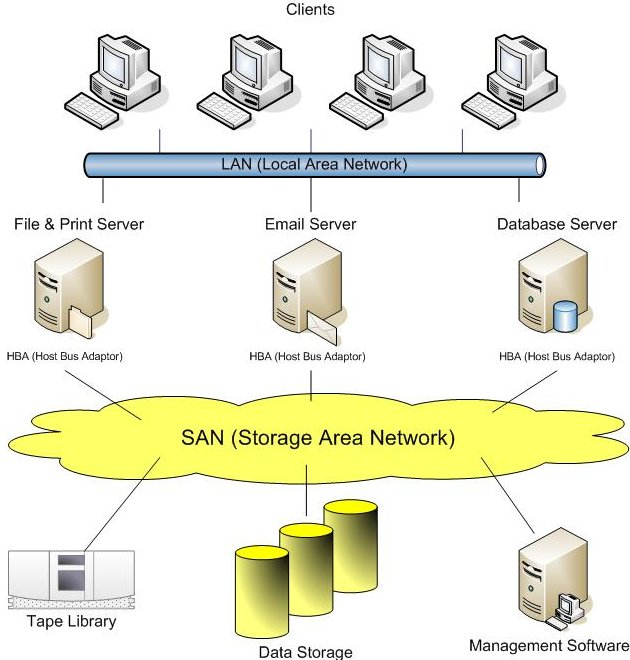
File Server
Multiple servers, from different vendors, on different operating systems can all be connected to a Storage Area Network (SAN). Unlike DAS (Direct Attached Storage), all servers connected to the Storage Area Network (SAN) can share all of the storage available, which reduces the overall cost per megabyte for your business.
Storage Area Network Fabric
The Storage Area Network (SAN) Fabric is effectively the SAN network that connects the servers to the storage. The Storage Area Network (SAN) Fabric is made up of 2Gb fibre channel switches (supplied by multiple vendors including CISCO, Brocade and IBM) which manage the connectivity from the servers HBA (Host Bus Adaptor) to the Storage Area Network (SAN) storage.
Host Bus Adaptors (HBA's)
PCI adaptor connects a server to the SAN fabric. Each HBA installed is referred to as a host. Two HBA's can be installed into each server for additional resilience.
Fibre Cabling
High speed fibre optic cabling used to interconnect between servers, storage and tape backup devices.
Tape library
Linking a tape library into the Storage Area Network (SAN) Fabric provides a fast and reliable solution to backup critical data. Data stored on the Storage Area Network (SAN) is transferred directly to the tape library, using "serverless" technology. This reduces the load on each server and ensures data is backed up within the time window available.
Management Software
The software enables individual components to be configured and optimised for performance. It monitors network for bottlenecks enabling IT Managers to preempt problems and adjust accordingly.

Centralised Data Storage and Backup Management
Storage Area Networks (SAN's) can provide an effective solution to the data storage demands of businesses today. With an estimated annual data growth of many companies, in excess of 100%, and data legislation on the increase, the storage and management of data is a critical issue. The amount of data stored in servers is constantly increasing and this is exposing the limitations of traditional storage devices where up to 50% of existing capacities can be unused due to their inherent nature.
The growth in data storage is also exposing the limitations of traditional back up devices, leading to increased downtime and insufficient protection in the event of a disaster. Businesses must look for new solutions to meet the demands of today's data storage and back up requirements. One such solution for data storage and effective backup management is to implement a Storage Area Network.
If your business is hindered by any of the following, then a Storage Area Network (SAN) may be the right option for your business.
Complex multiple server environment
Insufficient data storage capabilities
Low scalability
High administration costs associated with protecting data
Insufficient network data protection
Poor data access, especially for tape back ups and restoration
Inability to meet data storage legislation requirements / regulatory compliance